In the world we live in today, it is necessary to have reliable and fast network connections. RJ45 pass-through connectors are important tools in making network cables. These connectors aim to simplify installation, reduce wastage, and enhance the quality of cable terminations. This article provides an in-depth look into RJ45 pass-through connectors, including their design, advantages, and practical uses. Whether you have been working as a network technician for years or this is your first time setting up networks, after reading through this guide, all that will change because now, even without experience with how different networking environments function, one can still make use of RJ 45 pass-through connector correctly.
What Is an RJ45 Pass-Through Connector?
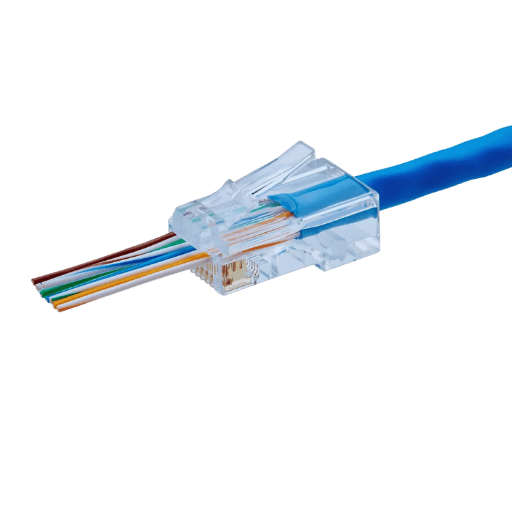
Understanding the RJ45 Connector
The RJ45 plug, also known as an 8P8C (Eight Location, Eight Contact) plug, is a universal interface that is mainly used in Ethernet networks. Such plugs are usually crimped on the end of twisted-pair network cables like CAT5e or CAT6 to provide physical connections between network devices. An individual wire in a network cable corresponds to each of the eight pins present in an RJ45 connector which enables data signals to be transmitted.
It is constructed in such a way that it should let through reputable data transfer using gold-plated pins that offer good conductivity and resist corrosion. The modular plug has a locking tab that latches into place upon being pushed into an RJ45 socket to ensure precise alignment and firm connection while minimizing the chances of getting disconnected.
Electrical performance-wise, these connectors are rated against categories of cables with which they can work best electrically; for instance, those designed for CAT5e cables can typically handle up to 1 Gbps speeds, while those meant for CAT6 cables can support 10 Gbps over short distances. It’s important, therefore, to choose an appropriate RJ45 connector according to the cable category so as not only to guarantee but also to sustain maximum performance levels within your network.
In general terms therefore; without this little guy we wouldn’t be able move information around different computers or devices very easily at all – would we?
Types of RJ45 Pass-Through Connectors
Making termination easier by permitting complete passage of wires through the connector before crimping, RJ45 pass-through connectors are designed. As a result, an accurate attachment is achieved and they exhibit stable performance.
Shielded Pass-Through Connectors: These provide extra electromagnetic interference (EMI) protection, making them suitable for areas with much electronic commotion.
Unshielded Pass-Through Connectors: These provide minimal EMI environments and have less complicated structures, hence their easier installation.
CAT5e Pass-Through Connectors: Created explicitly for CAT5e cables, these types of connectors support data transmission speeds of up to 1 Gbps.
CAT6 Pass-Through Connectors: Meant for CAT6 cables, these ones can handle ten gigabits per second over short distances.
The decision on which type of RJ45 pass-through connector depends on specific needs in the network as well as environmental factors.
Benefits of Using Pass-Through RJ45 Connectors
Pass-through RJ45 connectors have a number of benefits that improve performance and ease of use:
- Easy Termination Process: The design enables wires to pass through the connector, which helps in verifying the correct wiring order before crimping. This reduces mistakes and guarantees a solid connection.
- Better Performance: When wires are properly aligned with the connector, and there is consistent contact between them, signal integrity is enhanced, leading to reliable data transmission with minimal signal loss.
- Time Saving on Installation: It saves time during installation when you can see wire order before crimping hence suitable for professional installers as well as DIY enthusiasts.
- Flexibility: Pass-through connectors come with unshielded or shielded versions that can be used in various environments, such as high-EMI or low-EMI, and they are compatible with different cable types, including CAT5e and CAT6 cables.
In general, pass-through RJ45 connectors make network cable terminations easy, fast, and accurate, thereby contributing towards better overall network performance.
How Do You Use RJ45 Pass-Through Connectors?
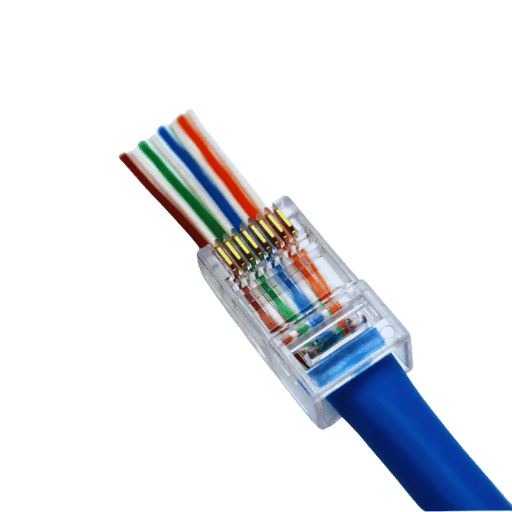
Tools Required for Termination
To effectively end the RJ45 pass-through connectors, you require the following:
- Crimping Tool: A unique tool meant to terminate pass-through connectors to ensure a precise and dependable crimp.
- Cable Stripper: Used to peel off the outer jacket of the cable and reveal the individual wires.
- Cutting Tool: This is important when getting rid of any excess wire after termination.
- Continuity Tester: This test checks whether wires are connected in the right arrangement and if they work properly.
These tools are important if one wants a professional and uniform end, minimizing mistakes and improving network connections.
Step-by-Step Guide to InstaIling Pass-Through Connectors
Prepare the wire:
- The jacket must be removed: Using a cable stripper, carefully take off the external cover of an ethernet cable so that each wire can be seen separately without causing any harm to them.
- Untwist and Straighten Wires: Split up pairs of wires and align them into one straight line, making it easier to work with.
Insert Wires Into Connector:
- Organize According to Standard: Arrange the wires in the right order following either T568A or T568B wiring standards.
- Put Through Connector: Push all straightened cables into corresponding slots of RJ45 pass-through connector. Their ends should come out on the front side thus allowing you see if they are arranged correctly.
Cut Off Excessive Wire:
- Tools for cutting can be used: Cut off extra length of cable which sticks out from behind plastic part in front side of connector with tool for cutting ensuring neatness and flushness.
Crimp Connector:
- Crimping tools can be used: Insert the connector containing the wires into a suitable slot at the crimping tool, then press the crimper’s handles strongly so that it secures connections by crushing metal pins down onto individual strands while simultaneously trimming away the rest of the wire sticking out beyond the plastic cover.
Test Cable:
- Continuity tester should be used: Verify terminated cable using continuity tester ensuring that wiring sequence is proper and there are no faults in whole length of this Ethernet cord.
These instructions will help you make reliable, professional terminations on RJ45 Pass-Through Connectors, which will improve the overall performance and integrity of your network connection.
Common Mistakes to Avoid
Incorrect Stripping of Cables:
- Not properly removing the outside covering of Ethernet cables may harm the inner wires. Use a designated cable stripper and apply light force to prevent any scraping or cutting into contained cords.
Order of Wiring is Wrong:
- Rearranging wire sequence as per T568A or T568B standard can lead to network difficulties. Before crimping, always verify the correctness of the order for appropriate alignment that enables connection.
Inadequate Crimping Technique:
- Failure to exert enough pressure while utilizing this tool may give rise to an unstable link. Ensure handles are firmly squeezed so as to fix them correctly with wires then cut off any additional part which terminates reliably.
What Are the Differences Between Cat5e and Cat6 Pass-Through Connectors?
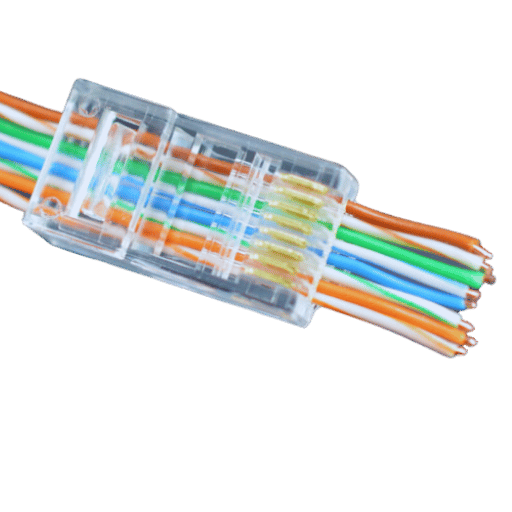
Compatibility with Ethernet Cables
Ethernet cables of Category 5e are supposed to be used with Cat5e pass-through connectors, while Cat6 pass-through connectors are made for Category 6 cables. What makes them dissimilar mainly refers to the performance specifications as well as physical structure; in comparison with cat5e cables, cat6 connectors can bear thicker gauge wire and tighter twists, which contribute towards better data transmission quality and reduced crosstalk. Although theoretically possible, using a cat 6 connector on a cat 5e cable is not advisable since this may affect performance outcome; hence, every connector should match its designated cable type for best results.
Performance Considerations
So as to think about information transmission speed and data transfer capacity capacities, one must assess the contrasts between Cat5e and Cat6 pass-through connectors. As far as separation is concerned, a cat6 connector supports faster speeds of up to 10 Gbps over shorter distances, i.e., 55 meters in particular, while cat5e connectors are mainly designed for up to 1 Gbps. Furthermore, it is worth mentioning that these categories have some differences when it comes to decreasing crosstalk and electromagnetic interference, whereby the inner structure of a cat six connector permits more tightly twisted pairs than any other types of cables, thus giving them better performance in this aspect. Hence, for networks with higher performance requirements, which need wider bands but less disturbance caused by adjacent wires, people should use cat six connectors instead of cat five e ones.
How to Choose Between Solid or Stranded RJ45 Connectors?
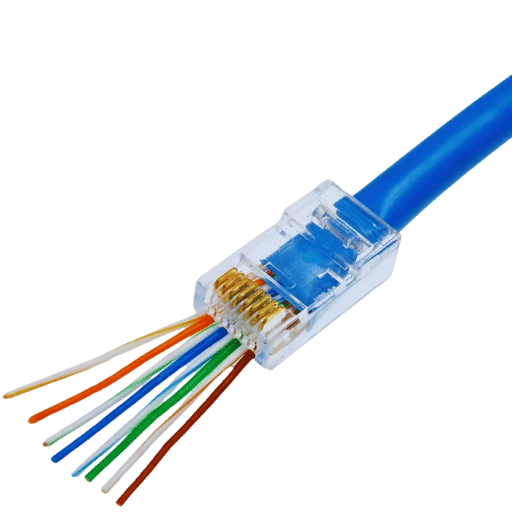
When to Use Solid UTP Cables
Fixed or permanent installations commonly use solid UTP (Unshielded Twisted Pair) cables because of their durability and performance benefits. These cables have one single conductor per wire, which means they are less flexible but more efficient for long distances.
Advantages of Solid UTP Cables
- Better Performance: Signal quality and data transmission are improved with solid UTP cables. It has a singular solid conductor that reduces signal attenuation thus making it best suited for networking environments where stable and reliable connection is required.
- Easy to Install: Solid UTP cables are rigid which makes them ideal for backbone cabling, in-wall installations, and long distance runs. They are widely used in constructing telecommunication wiring systems within buildings as well as data centers.
- Robustness: The strength of these types of cable enables them to withstand harsh environmental conditions; hence, they can withstand physical stress better than others if there is little movement involved in the installation process.
Data on the Use of Solid UTP Cables
- Bandwidth and Distance Coverage: Based on TIA/EIA standards, Gigabit Ethernet (1000Base-T) can be transmitted through solid UTP cables up to 100 meters (328 feet) without significant loss in signal integrity.
- Less Crosstalk: NEXT levels are lower in solid wires compared to stranded ones, resulting in better clarity during signal transmission, which is important for dense environments where high network performance must be sustained.
In conclusion, fixed high-performance systems that require good signal quality over long distances should utilize solid, Unshielded Twisted Pair cords; this arrangement provides the flexibility needed for durability alongside the stability during data transfer so common with current networking infrastructures.
When to Use Stranded UTP Cables
- Flexibility and Mobility: Stranded UTP cables contain multiple smaller wires twisted together, which allows them to be more flexible than solid UTP cables. This makes them perfect for patch cables and temporary networking setups where the cable will be moved or bent frequently.
- Short Runs: Because they can flex, stranded cables work best for connections over short distances within a room or between devices that are close together. They are commonly used for workstation connections and patch panels.
- Portability: Stranded UTP cables are easier to handle and install in environments where changes in cabling frequently occur because of their pliable nature; this ensures that even after regular manipulations, they remain physically robust enough for long-term use.
To put it simply, stranded UTP cables should be used for flexible, short-distance applications that involve moving or changing the network layout often. The design is meant for environments where adaptation and ease of installation are required most.
Testing Your Network Cable
To maintain good performance and connectivity, you must test your network cable correctly. Below is a short manual on how to effectively do it:
- Testing for continuity: This can be done by utilization of a network cable tester which will check whether all wires within the cable are connected properly without any breakage. Place the ends into the tester that shows if each pair of wire has been terminated rightly.
- Signal quality testing: Use a cable certifier to evaluate signal quality and performance. Signal-to-noise ratio (SNR), attenuation, and crosstalk are among some of the parameters measured with this equipment. High-quality signal transmission is essential for data integrity and reliability in the network.
- Performance testing: A performance tester should be employed to run benchmark tests on the network cable. These tests imitate real-world scenarios where data is being transmitted, ensuring that packets are not lost significantly because of low bandwidths or higher rates of latency.
- Visual inspection: Inspect visually for any physical damages, such as kinks, bends, or frayed ends, that might affect its working ability. The correct bend radius needs to be observed so that sharp angles are avoided, thereby preserving its integrity.
These are just a few of the many things you can do to ensure your network cables work well. This will help create a strong, reliable infrastructure for networking.
What Are Common Issues with RJ45 Pass-Through Connectors?
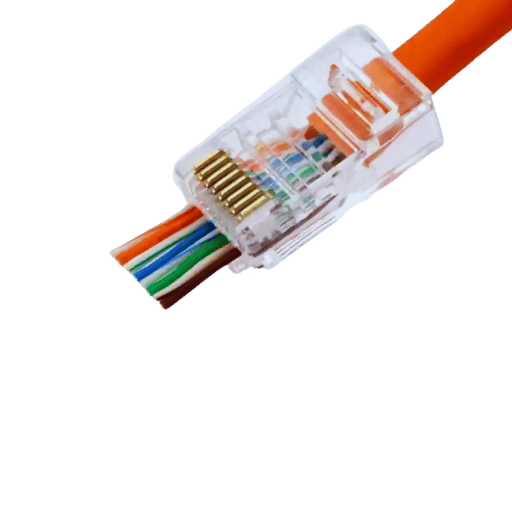
Connector and Cable Compatibility
Problems with compatibility between connectors and cables typically happen when their specifications don’t match. Pass-through RJ45 connectors are made for particular cable categories, such as Cat5e, Cat6, and Cat6A, among others; therefore, if you use a connector that is not rated for the cable type could cause bad performance. Make sure the insulation diameter of the connector matches that of the cable as well as wire gauge sizes to maintain good contact and signal integrity. When components do not match, signals may be lost, which can result in unreliable connections or even lead to network failure in some cases. Always confirm before installing anything whether these are indeed suitable based on their categories and the physical properties of the cables involved.
Issues with Crimping and Termination
According to some experts, poor cable crimping and termination have a big impact on how RJ45 pass-through connectors work. Some typical troubles include bad wire stripping, uneven pressure while crimping, or pins not being seated right. For you to be able to achieve dependable connections, here is what you should do:
- Wire Stripping: One must strip the jacket of the cable accurately without causing any damage to individual wires; otherwise, conductivity may be weakened, thus leading to poor connection.
- Process of Crimping: Ensure that you have used a high-quality tool made for pass-through connectors during the crimping process. Besides this, it’s also important to ensure that even pressure gets applied throughout so that all pins get seated properly, forming solid linkages.
- Alignment of Pins: Before starting your crimps, check if each wire is completely pushed into the connector and goes beyond its corresponding holes. In order, misalignment can cause low contact, hence signal deterioration.
- Visual Inspection: Once you’ve made connections, visually inspect them by looking for signs like partial crimps or misalignment. You should see all pins securely seated within their respective slots because this greatly affects performance.
The above are just a few steps one can take towards dealing with such issues, which, if not addressed, may lead to weak network links and other common problems associated with RJ45 pass-through connectors.
Where Can You Purchase RJ45 Pass-Through Connectors?

Top Online Retailers
- Amazon: The inventory and prices of Amazon are the best in the market. They have a wide range of RJ45 connectors with pass-through capabilities along with tools and kits for different network setups.
- Newegg: Newegg is an online retailer that sells mainly electronics and computer hardware. However, it also offers networking components such as RJ45 connectors, which come with detailed user reviews and technical specifications.
- Monoprice: Monoprice focuses on affordable network cables and accessories. It provides cheap but quality RJ45 pass-through connectors as well as related installation tools.
- Best Buy: Best Buy has brick-and-mortar stores across America and an online presence. It offers a variety of RJ45 connectors for pass-through needs, among other networking supplies, and it offers in-store pickup options.
- B&H Photo Video: B&H started out selling photography equipment but has now expanded to include all sorts of electronics, including networking items like RJ45 pass-through connectors, which can be reliably purchased from them.
Buying in Bulk or 100-Pack Options
There are many benefits to think about when purchasing RJ45 pass-through connectors in large quantities or in 100-packs. Often, the price per connector is lower when bought in bulk, which makes it an affordable choice for medium to big-sized network projects. This method is particularly useful for businesses, IT departments, and people who regularly do network installations or maintenance work. Additionally, having a lot of them in stock guarantees that you will be ready for any unexpected jobs or repairs that may come up, thereby minimizing downtime. Many retailers, such as Amazon and Monoprice, offer this option so you can save money and time at the same time.
What to Look for When Buying RJ45 Pass-Through Connectors
If you want to purchase RJ45 pass-through connectors, there are a few essential things that you should consider to ensure the best possible quality and performance:
- Compatibility – Make sure that the connectors match the Ethernet cables of the same category (Cat5e, Cat6, Cat6A, etc.). This way, they should work well together without any issues during installation or use.
- Quality of materials—Look for robustness in connector design through its choice of material. For example, using gold-plated contacts can help prevent corrosion while improving connection reliability.
- Ease-of-use—Choose connectors that can be easily installed. One such option is those that feature clear pass-through designs, which allow for visual inspection prior to crimping. This reduces mistakes made throughout installations and saves time.
- Brand reputation – You might consider buying from reliable brands with good track records on networking products’ quality and reliability. Some examples include Platinum Tools, Klein Tools, and Legrand, which are highly regarded within this field.
- User reviews—It could also be helpful to review customer feedback ratings found at sites like Amazon, Newegg, or even Monoprice to obtain real-world opinions regarding connector performance and dependability. Positive endorsements from professionals as well as enthusiasts could serve as an indication of a product’s trustworthiness.
By following these guidelines, one can choose fast RJ45 pass-through connectors that satisfy their needs in terms of efficiency and durability.
Reference Sources
Category 6 cable
Modular connector
Electrical connector
Frequently Asked Questions (FAQs)
Q: Exactly what is an RJ45 pass-through connector?
A: Pass-thru or RJ45 pass-through connectors are only one type of RJ45 plug that allows each wire into the connection to be pushed in and cut off flush during termination for better connections and less waste.
Q: Which should I choose, solid or stranded UTP, for my RJ45 pass-through connectors?
A: The choice between solid and stranded UTP depends on the application. Typically, solid UTP is used for longer runs in fixed installations such as inside walls or between floors, while stranded UTP is more appropriate for shorter, flexible connections like patch cables that might be moved frequently.
Q: What makes cat5e RJ45 connectors different from cat6 pass-through connectors?
A: Cat5e RJ45 connectors are designed for enhanced Ethernet (1000 Mbps), while Cat6 pass-through connectors are rated for gigabit ethernet channel-compliant networks with improved performance, especially at higher frequencies associated with Cat 6 cables and networks.
Q: Are RJ45 pass-through modular plugs compatible with Cat 6 cables?
A: Yes, they are. Nevertheless, ensure you employ cat6 pass-through connectors, which can deal with high frequencies and performance requirements of Cat 6 Ethernet.
Q: Which special tools do I need to crimp RJ45 pass-through connectors?
A: You will require either a Pass-Through crimper or an RJ45 Crimp Tool that can properly cut and crimp Pass-Through Plugs. These tools provide a secure, reliable connection every time.
Q: How can I tell if my crimper is compatible with RJ45 pass-through plugs?
A: Use a crimper that is suitable for use with rj-45 passthrough modular plugs to avoid compatibility issues. The tool should cut the excess wire and crimp the plug correctly to maintain good connection quality.
Q: Can I use unshielded cabling with RJ45 pass-through connectors or only shielded cables?
A: RJ45 pass-through connectors come in different types, and there are unshielded pass-through RJ45 modular plugs that can be used for unshielded cabling. Just make sure to match the right type of connector with your cable to maintain network performance and minimize interference.
Q: What are some advantages of using pass-through RJ45 modular plugs?
A: Pass-thru connectors or pass-through rj-45 modular plugs have several benefits, such as easier wire alignment during installation, less damage to wires from wrong cuts made on them, as well as more reliable connections due to the precision offered by this type of connector.
Q: Do they sell RJ45 cat6 pass-through connectors in bulk packs?
A: Yes, they do. For instance, you can find a 100-pack rj45 cat6 pass. Bulk packs offer a cost-effective way of buying larger quantities needed for big projects while at the same time ensuring continuous supply.
Post Views: 6,746





